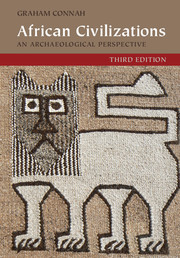Book contents
- Frontmatter
- Dedication
- Contents
- List of figures
- Preface and acknowledgements
- 1 The context
- 2 Origins: social change on the lower Nile
- 3 The Mediterranean frontier: North Africa
- 4 Sudanic genesis: Nubia
- 5 Isolation: the Ethiopian and Eritrean Highlands
- 6 Opportunity and constraint: the West African savanna
- 7 Achieving power: the West African forest and its fringes
- 8 Indian Ocean networks: the East African coast and islands
- 9 Cattle, ivory, and gold: social complexity in Zambezia
- 10 Central Africa: the Upemba Depression, Interlacustrine Region, and Far West
- 11 Settlement growth and emerging polities: South Africa
- 12 What are the common denominators?
- References
- Index
11 - Settlement growth and emerging polities: South Africa
Published online by Cambridge University Press: 05 November 2015
- Frontmatter
- Dedication
- Contents
- List of figures
- Preface and acknowledgements
- 1 The context
- 2 Origins: social change on the lower Nile
- 3 The Mediterranean frontier: North Africa
- 4 Sudanic genesis: Nubia
- 5 Isolation: the Ethiopian and Eritrean Highlands
- 6 Opportunity and constraint: the West African savanna
- 7 Achieving power: the West African forest and its fringes
- 8 Indian Ocean networks: the East African coast and islands
- 9 Cattle, ivory, and gold: social complexity in Zambezia
- 10 Central Africa: the Upemba Depression, Interlacustrine Region, and Far West
- 11 Settlement growth and emerging polities: South Africa
- 12 What are the common denominators?
- References
- Index
Summary
In this chapter, ‘South Africa’ describes the extremity of the continent south of a line from the Limpopo River, in the east, to Walvis Bay, in the west. It consists of the Republic of South Africa, together with southern parts of Namibia, Botswana, and Mozambique, as well as Lesotho and Swaziland, although attention will be limited to the first of these modern states. Two characteristics of the archaeology of this region are of relevance to the subject of urban and state origins in Africa. First, environments in which trees were rare or absent resulted in the use of drystone construction for parts of many settlements, rendering them highly visible archaeologically, particularly if subsequently abandoned during the turbulent history of recent centuries. This allows detailed analysis of the layout of settlements and their relationship to landscapes. Second, the sociopolitical developments that are the subject of this book took place in South Africa within the last five hundred years at most and in many cases more recently, so that both documentary records and oral traditions are copious and valuable sources of information. In addition, linguistic and genetic studies can provide information on the relationships and movements of ethnic groups, to which investigations of pottery and other aspects of material culture can contribute. Thus, in the case of South Africa, we can examine processes of change for which there is much less evidence in some other parts of the continent at earlier dates. Not only can this throw light on the development of complexity in Africa as a whole, but an investigation of the South African data also has global relevance.
Geographical location and environmental factors
Mixed farming seems to have been well established in South Africa by the middle of the second millennium AD. However, the western and south-western parts of this huge area were too dry to grow African cereal crops or had winter rainfall instead of the necessary summer rainfall. In those parts of southern Africa, livestock-herding, hunter-gathering, or a combination of the two remained the subsistence strategies until European colonization over the last three hundred years or so. In contrast, to the east and north-east both cultivation and livestock, particularly cattle, were important.
- Type
- Chapter
- Information
- African CivilizationsAn Archaeological Perspective, pp. 330 - 346Publisher: Cambridge University PressPrint publication year: 2015



